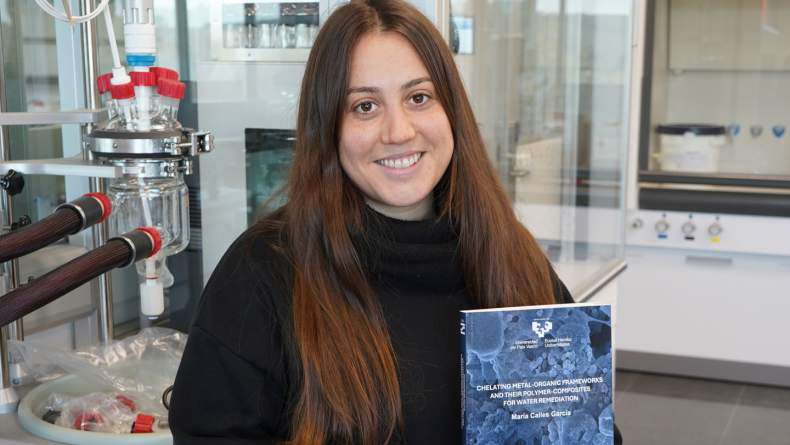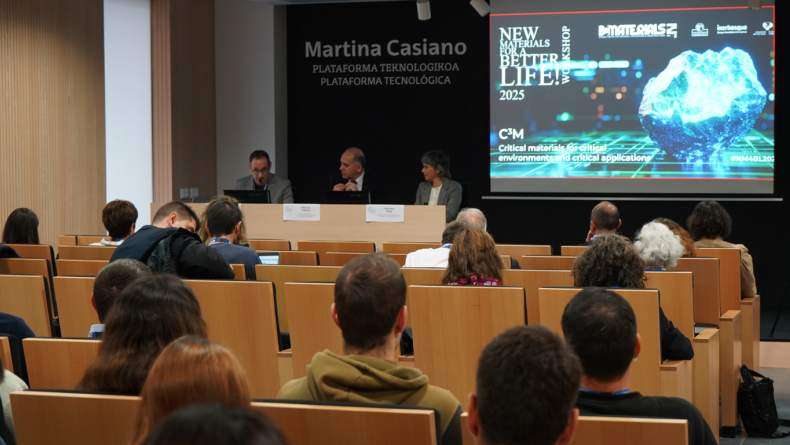“State of the Art on New Materials” Seminar series starting November the 8th

It is our pleasure to announce the “State of the Art on New Materials” Seminar series starting November the 8th, as part of our MSc on New Materials.
8 Nov 2012: Francisco del Monte (Instituto de Ciencia de Materiales de Madrid, CSIC, Spain)
Bioinspired Materials
The most complex hierarchically organized chemical structures (e.g., from the nanoworld of proteins to the macroscopic structures of oyster shells, bone and enamel, among others) can be found in nature. This is why the imitation of Nature has called the attention of numerous research groups during the last years. The understanding of the processes through which inorganic atoms and organic macromolecules self-assemble into organized architectures and complex forms must allow for the design of new bioinspired routes for materials preparation. In this talk, we will describe different bioinspired approaches, from regular synthetic processed based on self-assembly providing hierarchical materials to those in which the resulting material comes from the activity of enzymes up to those carried out by microorganisms themselves. We will also see how the performance of these materials (irrespective of the particular field of application, ranging from microbial fuel cells and supercapacitors to biomaterials) depends on the integration of the individual components into the hierarchical structure.
23 Nov 2012: Kiyonori Suzuki (Department of Materials Engineering, Monash University, Clayton, Victoria 3800, Australia.)
Magnetic nanostructures: From exchange softening in nanostructured alloys to charge-transfer ferromagnetism in capped nanoparticles.
Two main research problems in magnetic nanostructures tackled by our group at Monash University are (i) the influence of macroscopic induced anisotropies on the local random magnetocrystalline anisotropies in Fe based alloys and (ii) the effect of chemical capping or doping on inducing spontaneous magnetization in intrinsically nonmagnetic materials. The former problem is directly linked to the efficiency of soft magnetic cores used in electric motors, a vital component in realization of low-emission automotive technology. The latter effect is potentially relevant to the development of magnetic semiconductors, an essential ingredient in spintronics. A brief overview of our recent progress in these research areas including the synthesis of nanoparticles and nanostructured alloys, the results of synchrotron experiments and modeling of the exchange softening process will be given. This progress has been made in collaboration with researchers from Australia (N. Ito, S.J. Chen, K. Saito, J.D. Cashion, N. Medhekar, B. Cowie), Germany (G. Herzer), Japan (M. Suzuki) and Spain (J.S. Garitaonandia, E. Goikolea, M. Insausti).
 3 Dic 2012: George C. Hadjipanayis (2012 Distinguished Lecturer of the IEEE Magnetics Society, Department of Physics and Astronomy Sharp Lab, University of Delaware, USA)
Science and Technology of Modern Permanent Magnet Materials
Permanent magnets (PMs) are indispensable for the electric, electronic and automobile industries, information technologies, automatic control engineering and many other commercial and military applications. In most of these applications, an increase in the magnetic energy density of the PM, usually presented via the maximum energy product (BH)max, immediately increases the efficiency of the whole device and makes it smaller and lighter. Worldwide demand for high performance PMs has increased substantially in the past few years driven by hybrid and electric cars, wind turbines and other power generation systems. A dramatic improvement in the performance of PMs was made during the 20th century, with (BH)max increased by more than 100 times, as a result of major advances in solid state physics, materials science and metallurgy. However, new energy challenges in the world require devices with higher energy efficiency and minimum environmental impact. The potential of 3d-4f compounds that revolutionized PM science and technology is nearly fully utilized, and the supply of 4f rare earth elements is no longer assured. This lecture will cover the major principles guiding the development of PMs, including the important role of microstructure on coercivity, and overview state-of-the-art theoretical and experimental research. Recent progress in the development of nanocomposite PMs, consisting of a fine (at the scale of magnetic exchange length) mixture of phases with high magnetization and large magnetic hardness will be discussed. Fabrication of such PMs is currently the most promising way to boost the (BH)max, while simultaneously decreasing, at least partially, the reliance on the rare earth elements. Current efforts in the development of high performance non-rare earth magnets and their future prospects will also be discussed.
3 Dic 2012: George C. Hadjipanayis (2012 Distinguished Lecturer of the IEEE Magnetics Society, Department of Physics and Astronomy Sharp Lab, University of Delaware, USA)
Science and Technology of Modern Permanent Magnet Materials
Permanent magnets (PMs) are indispensable for the electric, electronic and automobile industries, information technologies, automatic control engineering and many other commercial and military applications. In most of these applications, an increase in the magnetic energy density of the PM, usually presented via the maximum energy product (BH)max, immediately increases the efficiency of the whole device and makes it smaller and lighter. Worldwide demand for high performance PMs has increased substantially in the past few years driven by hybrid and electric cars, wind turbines and other power generation systems. A dramatic improvement in the performance of PMs was made during the 20th century, with (BH)max increased by more than 100 times, as a result of major advances in solid state physics, materials science and metallurgy. However, new energy challenges in the world require devices with higher energy efficiency and minimum environmental impact. The potential of 3d-4f compounds that revolutionized PM science and technology is nearly fully utilized, and the supply of 4f rare earth elements is no longer assured. This lecture will cover the major principles guiding the development of PMs, including the important role of microstructure on coercivity, and overview state-of-the-art theoretical and experimental research. Recent progress in the development of nanocomposite PMs, consisting of a fine (at the scale of magnetic exchange length) mixture of phases with high magnetization and large magnetic hardness will be discussed. Fabrication of such PMs is currently the most promising way to boost the (BH)max, while simultaneously decreasing, at least partially, the reliance on the rare earth elements. Current efforts in the development of high performance non-rare earth magnets and their future prospects will also be discussed.
 3 Dic 2012: George C. Hadjipanayis (2012 Distinguished Lecturer of the IEEE Magnetics Society, Department of Physics and Astronomy Sharp Lab, University of Delaware, USA)
Science and Technology of Modern Permanent Magnet Materials
Permanent magnets (PMs) are indispensable for the electric, electronic and automobile industries, information technologies, automatic control engineering and many other commercial and military applications. In most of these applications, an increase in the magnetic energy density of the PM, usually presented via the maximum energy product (BH)max, immediately increases the efficiency of the whole device and makes it smaller and lighter. Worldwide demand for high performance PMs has increased substantially in the past few years driven by hybrid and electric cars, wind turbines and other power generation systems. A dramatic improvement in the performance of PMs was made during the 20th century, with (BH)max increased by more than 100 times, as a result of major advances in solid state physics, materials science and metallurgy. However, new energy challenges in the world require devices with higher energy efficiency and minimum environmental impact. The potential of 3d-4f compounds that revolutionized PM science and technology is nearly fully utilized, and the supply of 4f rare earth elements is no longer assured. This lecture will cover the major principles guiding the development of PMs, including the important role of microstructure on coercivity, and overview state-of-the-art theoretical and experimental research. Recent progress in the development of nanocomposite PMs, consisting of a fine (at the scale of magnetic exchange length) mixture of phases with high magnetization and large magnetic hardness will be discussed. Fabrication of such PMs is currently the most promising way to boost the (BH)max, while simultaneously decreasing, at least partially, the reliance on the rare earth elements. Current efforts in the development of high performance non-rare earth magnets and their future prospects will also be discussed.
3 Dic 2012: George C. Hadjipanayis (2012 Distinguished Lecturer of the IEEE Magnetics Society, Department of Physics and Astronomy Sharp Lab, University of Delaware, USA)
Science and Technology of Modern Permanent Magnet Materials
Permanent magnets (PMs) are indispensable for the electric, electronic and automobile industries, information technologies, automatic control engineering and many other commercial and military applications. In most of these applications, an increase in the magnetic energy density of the PM, usually presented via the maximum energy product (BH)max, immediately increases the efficiency of the whole device and makes it smaller and lighter. Worldwide demand for high performance PMs has increased substantially in the past few years driven by hybrid and electric cars, wind turbines and other power generation systems. A dramatic improvement in the performance of PMs was made during the 20th century, with (BH)max increased by more than 100 times, as a result of major advances in solid state physics, materials science and metallurgy. However, new energy challenges in the world require devices with higher energy efficiency and minimum environmental impact. The potential of 3d-4f compounds that revolutionized PM science and technology is nearly fully utilized, and the supply of 4f rare earth elements is no longer assured. This lecture will cover the major principles guiding the development of PMs, including the important role of microstructure on coercivity, and overview state-of-the-art theoretical and experimental research. Recent progress in the development of nanocomposite PMs, consisting of a fine (at the scale of magnetic exchange length) mixture of phases with high magnetization and large magnetic hardness will be discussed. Fabrication of such PMs is currently the most promising way to boost the (BH)max, while simultaneously decreasing, at least partially, the reliance on the rare earth elements. Current efforts in the development of high performance non-rare earth magnets and their future prospects will also be discussed.Related news
María Calles, New Doctor of BCMaterials
We would like to congratulate María Calles García for obtaining her PhDs in Materials Science and Technology from the UPV/EHU. On December 4 made a brilliant defense of her thesis titled ‘Chelating…Invited Talk with Barcelona Microelectronics Institute’s researchers (December 3)
On December 3 at 12:00 PM, in the Martina Casiano Auditorium in Leioa, BCMaterials will host senior researchers Antón Guimerà and Xavier Illa from the Barcelona Microelectronics Institute (IMB-CNM,…Invited Talk by Liu Yao on Lithium-Metal Batteries (December 2)
Next Monday, December 2, Liu Yao, professor at the Shanghai Institute of Applied Physics, will give an invited lecture at BCMaterials entitled ‘Li-Metal Batteries: From Liquid to Solid-State’. The…Success of BCMaterials’ Annual Workshop on Critical Materials
The 2025 edition of BCMaterials’ annual workshop gathered nearly one hundred participants on November 19 in Leioa to review the latest advances and discuss critical materials, their applications, and…



